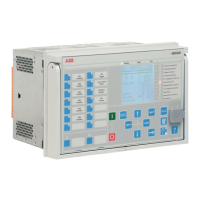The methods may not be applicable where additional current channels or voltage
channels are not available. This CT secondary circuit supervision presents an
algorithm that can be used as an example for detecting the CT secondary failure
used for the unit protection of a two-winding or three-winding transformer.
However, the function has a limitation that it cannot detect failure in case
of equipment under protection in no-load condition or when two simultaneous
secondary CT failures occur.
The detection of a zero current in any one phase is a partial indication of failure in
the current transformer secondary. Furthermore, if this current zero is due to the
failure in the current transformer secondary, it results in a change in the magnitude
of the negative-sequence current in the group only where current zero has been
detected. However, changes in the negative-sequence current in other groups of
three-phase current transformers at the instance of zero-current detection is an
indication of a system problem. Also, it may happen that after the detection of a
failure in the current transformer secondary, a fault may occur in the system. During
such condition, functions are internally blocked.
Phase discontinuity
A zero current detected due to the phase discontinuity results in an asymmetry
in all the sets of the current transformer, which then results in a change in the
negativesequence current (ΔI
2
) in the healthy set. This change in the negative-
sequence current on the healthy sides, that is, other than where a zero current has
been detected, blocks the function.
In case of a lightly loaded transformer (up to 30 %) the change in the
negativesequence current may be very negligible. However, a phase discontinuity
results in a change in the phase angle difference between two healthy phases in the
set of CTs where a zero current has been detected as well as on the primary side of
the transformer. This change in the value of the angle blocks the function internally.
Overload / System short circuit condition
It is required that any overload or short circuit conditions after a CT failure
should block the function. During overload or short circuit condition, the phase
current increases beyond its rated value; if any phase current on any set of
current transformer exceeds the set limit, the function is blocked internally. Also
in case of an unsymmetrical fault, the negative-sequence current increases. If the
negativesequence current increases beyond the set limit, the function is blocked
internally. The overcurrent and negative-sequence current setting both can be set
equal to the overcurrent and negative-sequence protection function start value.
The internal blocking is thus useful for avoiding false operation during a fault
situation.
Supervision functions
1MRS757644 H
888 620 series
Technical Manual

